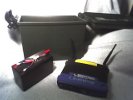|
NOTE: by setting up your main router to forward all 10.x packets to the mesh you will be allowing any device that connects to your network to send out data. One must be espcialy careful that random devices do not attempt to send content that would not be in compliance with Amateur Radio regulations. What you are trying to do is actually much more of a DD-WRT question than it is a BBHN question because it relates to configuring your router rather than the mesh node. The documentation on the DD-WRT site will likely be able to provide much more detailed information than this short snippit should you require more details.
1) DD-WRT router would need a static route to 10.x to point towards the mesh node IP address on the interface the mesh node is connected.
2) DD-WRT would need its dns server configured to forward queries to the mesh node: http://cybernetnews.com/local-internal-dns-ddwrt/ http://www.thekelleys.org.uk/dnsmasq/docs/setup.html "Using special servers.
Dnsmasq has the ability to direct DNS queries for certain domains to specific upstream nameservers. This feature was added for use with VPNs but it is fully general. The scenario is this: you have a standard internet connection via an ISP, and dnsmasq is configured to forward queries to the ISP's nameservers, then you make a VPN connection into your companies network, giving access to hosts inside the company firewall. You have access, but since many of the internal hosts aren't visible on the public internet, your company doesn't publish them to the public DNS and you can't get their IP address from the ISP nameservers. The solution is to use the companies nameserver for private domains within the company, and dnsmasq allows this. Assuming that internal company machines are all in the domain internal.myco.com and the companies nameserver is at 192.168.10.1 then the option server=/internal.myco.com/192.168.10.1 will direct all queries in the internal domain to the correct nameserver. You can specify more than one domain in each server option. If there is more than one nameserver just include as many server options as is needed to specify them all."
Where the server line is something like "server=/local.mesh/nodeipaddress" --- all DNS access would have to be done as http://nodename.local.mesh for this to work |
